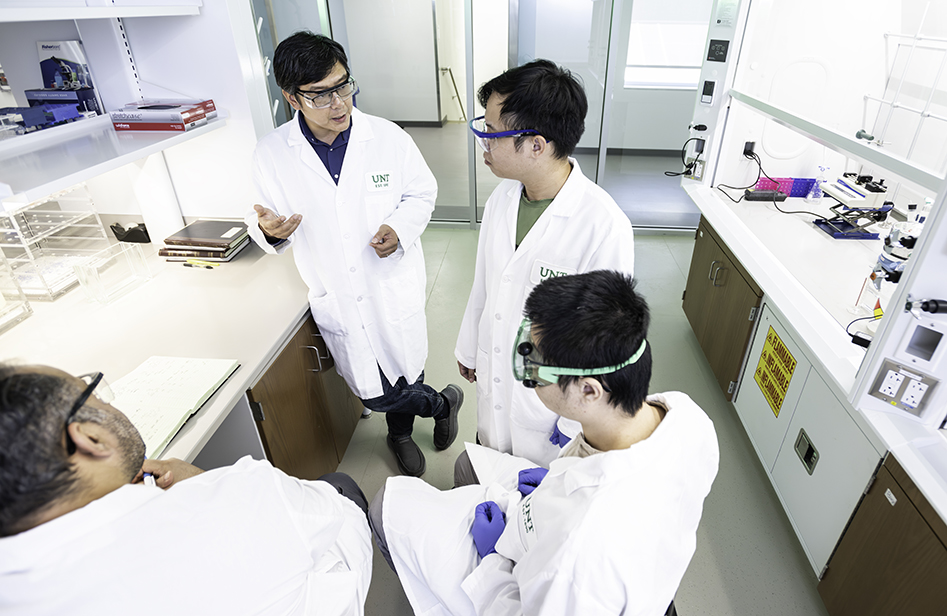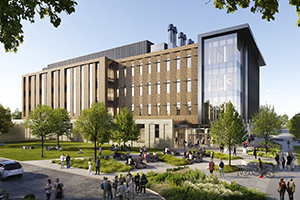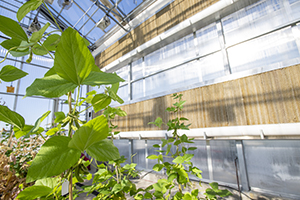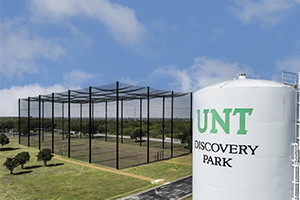Science Building Updgrades
 The University of North Texas completed a $14 million renovation inside its Science
Research Building.
The University of North Texas completed a $14 million renovation inside its Science
Research Building.
The most recent updates have transformed the building’s second floor into a more collaborative space for researchers in the College of Science, who collectively bring in millions of dollars in sponsored project awards annually for research advancing a variety of fields — from the development of sustainable biotechnologies and next-generation semiconductors to finding solutions that address environmental and health challenges in society.
The 34,000-square-foot floor includes 10 private faculty offices, 54 workspaces for graduate student researchers, two collaborative huddle rooms, a conference room and a multipurpose break/collaborative space. There also are support spaces for autoclave and glass washing, chemical storage, equipment, microscopy and tissue culture. Open-concept laboratories with ample natural light allow for researchers such as Xin Cui (pictured above) in chemistry and others in biological sciences and physics to work alongside each other, introducing new opportunities for joint scholarship and solutions.
“A lot of thought went into creating a floor plan that encourages collaboration between research groups,” College of Science Dean John Quintanilla says. “This new inviting space encourages even more cross-disciplinary research at UNT and will surely help incubate exciting new ideas for many years to come.”
Science and Technology Building
 UNT is constructing a 111,000-square-foot multidisciplinary research building that
will support its historic growth as a Carnegie-ranked Tier One public research university.
In addition to more collaborative spaces for interdisciplinary research, the new Science
and Technology Building will create experiential learning opportunities for students.
The project is funded by $103.4 million in tuition revenue bonds authorized by the
87th Texas Legislature in 2021.
UNT is constructing a 111,000-square-foot multidisciplinary research building that
will support its historic growth as a Carnegie-ranked Tier One public research university.
In addition to more collaborative spaces for interdisciplinary research, the new Science
and Technology Building will create experiential learning opportunities for students.
The project is funded by $103.4 million in tuition revenue bonds authorized by the
87th Texas Legislature in 2021.
Materials Research Facility
 UNT’s Materials Research Facility at Discovery Park is one of the most advanced university
research facilities in the nation for materials analysis — from the atomic to macro
scales. The facility already offers a suite of powerful analytical instruments used
for true 3D characterization and processing and will significantly enhance its microscopy
capabilities over the next year with support from the Texas University Fund.
UNT’s Materials Research Facility at Discovery Park is one of the most advanced university
research facilities in the nation for materials analysis — from the atomic to macro
scales. The facility already offers a suite of powerful analytical instruments used
for true 3D characterization and processing and will significantly enhance its microscopy
capabilities over the next year with support from the Texas University Fund.
Greenhouse Facilities
 The UNT Greenhouse Research Core Facilities include three greenhouse complexes — two
on the main campus and one at UNT’s Discovery Park, the largest research park in the
North Texas region. The facilities, which have been upgraded, support an array of
plant research, including projects focused on corn and soybeans, as well as fiber
work with cotton, jute and kenaf. The work contributes to the growing Texas and national
bioeconomy by providing bio-based alternatives to traditional materials.
The UNT Greenhouse Research Core Facilities include three greenhouse complexes — two
on the main campus and one at UNT’s Discovery Park, the largest research park in the
North Texas region. The facilities, which have been upgraded, support an array of
plant research, including projects focused on corn and soybeans, as well as fiber
work with cotton, jute and kenaf. The work contributes to the growing Texas and national
bioeconomy by providing bio-based alternatives to traditional materials.
Air Mobility Testing Facility
 The 36,000-square-foot UNT Advanced Air Mobility (UAAM) testing facility at Discovery
Park is the largest of its kind in Texas and one of the biggest nationally. Researchers
can analyze drone technology, such as how specific maneuvers impact performance; explore
safety measures like collision avoidance; and test communication between uncrewed
aerial vehicles and stationary receivers or autonomous vehicles on the ground.
The 36,000-square-foot UNT Advanced Air Mobility (UAAM) testing facility at Discovery
Park is the largest of its kind in Texas and one of the biggest nationally. Researchers
can analyze drone technology, such as how specific maneuvers impact performance; explore
safety measures like collision avoidance; and test communication between uncrewed
aerial vehicles and stationary receivers or autonomous vehicles on the ground.